Unimodal biometrics uses the single source of physiological/biological characteristics (e.g. face, fingerprint, online signature, DNA) for person authentication. So, if any issue persists in the person’s physiological/biological traits then the system leads to serious issue. To overcome this issue, we move into the Multimodal biometrics. Multimodal biometrics is the integration of two or more types of biometrics (e.g. Fingerprint and Face, Face and Iris, Iris and Fingerprint).In Multi biometrics the noise in any one of the biometrics will lead to high false reject rate (FRR) while identification. If any multi biometrics failure means, we can use another type of multi biometrics. To keep the biometric template as secure we use the soft computing technique i.e. Fuzzy Logic. The proposed work is to enhance the security in ATM system with multimodal biometrics along with email verification code which provides two level securities to the system. General Terms: Biometric Cryptosystem, Security, Biometrics, Template Protection
General Terms |
| Biometric Cryptosystem, Security,
Biometrics, Template Protection |
Keywords |
| ATM (Automated Teller
Machine),Biometric Cryptosystem, Biometrics, Face
recognition, Fingerprint recognition, Iris recognition,
Multi biometrics, Multimodal biometrics, Template
Protection, Two-tier security. |
INTRODUCTION |
| Biometrics [6] is a combination of two words”bio” (life)
and “metrics” (to measure).It is used to authenticate the
person’s physical behavioral characteristics. Biometrics
system based on single source of information is called
Unimodal biometrics system. Multimodal biometrics
system is the integration of two or more biometric systems. The integration of two of biometrics gives more
secure and meets user satisfaction. After determining
which type of biometric sources to be integrated the next
step is to build the system architecture. Fuzzy logic
means “partial truth”. It may have a truth value that
ranges in degree between 0 and 1.
Multimodal biometric system can operate in three
different modes [11]: |
| Serial Mode – It checks each modality before
the next modality to be investigated. It is also
known as cascade mode.
Parallel Mode – It combines all the information
modalities are processed together to perform
recognition.
Hierarchical Mode – It forms treelike structure
for the combination of individual classifiers |
| Multimodal biometrics is designed to operate in the
following five scenarios: |
| Multiple Sensors – It combines the different
biometric information of a single user from
different sensors.
Multiple Biometric– Different biometric
characteristics of a single user can be combined.
It will obtain from different sensors.
Multiple Units of the same Biometric – Iris
from left and right side of the eyes of a single
person may be combined.
Multiple Snapshots of the Same Biometric–
Collects multiple snapshots of the same instance
are combined for recognition and enrollment.
Multiple Representations and Matching
Algorithms for the same biometrics –
Combining various approaches to feature
extraction and matching of the multi biometrics. |
| The rest of the paper is organized as follows: The section
2 presents the existing unimodal biometrics in ATM
multi biometrics in ATM which overcomes the problem of unimodal biometrics. Multimodal biometrics and two
tier security is used to enhance the security of ATM in
section 3 and section 4. In section 5 performance
evaluation has been presented and in section 6
conclusions has been presented. |
II. UNIMODAL AND MULTIMODAL BIOMETRICS |
| Biometrics are classified into three Categories [6]
i) Physical biometrics ii) Biological biometrics iii) Soft
biometrics. Physical biometrics is static. It does not
change. It includes fingerprint, face, iris, retina etc..,.
Biological biometrics is dynamic. It can change. It
includes signature, keystroke, handwriting and gait. Soft
biometrics refers human characteristics. It includes
height, weight and color of hair. |
| 2.1 Unimodal Biometrics |
| The most successful technology used in ATM system is
Fingerprint recognition [7].Because the fingerprint is not
changing his Characteristic in the human being life Span.
So, all the ATM systems preferred finger print
recognition only. After the user inserts the card into the
ATM enter their PIN number into the system. If it
matches with the PIN number stored in the Database.
The next step is to enroll their fingerprint biometric
identity with the ATM system. If it matches with the
template that stored in the database, the system allows
the user to access the account. If it mismatches, the card
will be ejected. |
| A fingerprint biometric technique is fused with the ATM
for person authentication to ameliorate the security
level was dealt. In the world today, fingerprint is one of
the essential variables used for enforcing security and
maintaining a reliable identification of any individual.
The result of the survey conducted by the International
Biometric Group (IBG) in 2004 on comparative analysis
of fingerprint with other biometrics is presented in the
Figure 1. |
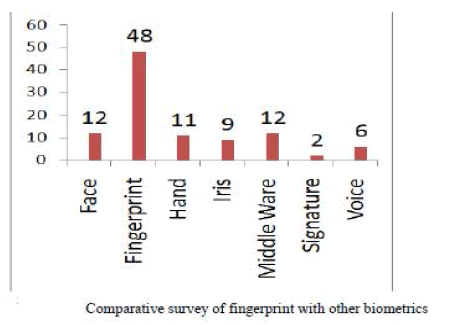 |
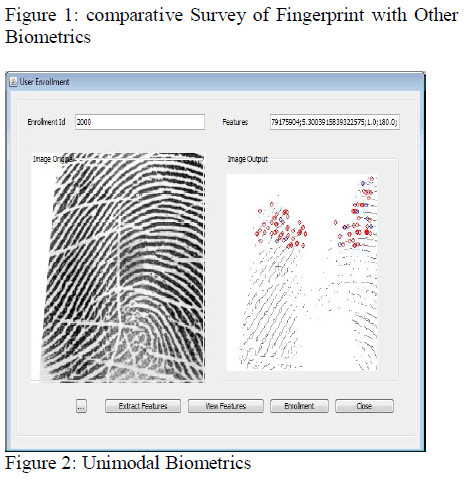 |
| 2.2 Multimodal Biometrics
Memorizing a password for a human being during his
life span is more difficult. So only Unimodal biometrics
was developed. In that too, there are many difficulties to
face. So that in order to develop the biometrics, now they
developed multimodal biometrics. In the Multimodal
biometrics [1], it has the combination of two or more
biometrics. For securing the biometric template here they
used the concept of Fuzzy Logic from Soft Computing.
Fuzzy logic is the concept of “partial truth” that defines
the matching performance between the stored template
and the present given input. The matching value between
the templates is between 0 to 1.The biometric
cryptosystem approach for multi biometric template
protection is for two reasons. Well-known biometric
cryptosystems such as fuzzy vault and fuzzy
commitment are available for securing [1] a different
type of biometric features and it is relatively easy to
analyze the security (non invariability) of a secure sketch
by leveraging on the characteristics of error correcting
codes. Multi biometrics is a combination of one or more
biometrics is implemented in ATM. Feature level fusion
makes use of embedding algorithms to convert different
biometrics into common representation [17]. |
| Embedding algorithm converts binary strings to pointsets,
point-sets to binary strings and fixed-length realvalued
vectors to binary strings. Biometric cryptosystems
have been designed only for specific biometric feature
representations. The fuzzy commitment scheme assumes a binary string representation, where the dissimilarity
between template and query is measured in terms of the
Hamming distance.
Matching performance of a biometric system is based on
False Acceptance Rate (FAR), False Reject Rate (FRR),
and Genuine Acceptance Rate (GAR). |
| a binary string representation, where the dissimilarity
between template and query is measured in terms of the
Hamming distance.
Matching performance of a biometric system is based on
False Acceptance Rate (FAR), False Reject Rate (FRR),
and Genuine Acceptance Rate (GAR). |
III. MULTIMODAL BIOMETRICS IN ATMSYSTEM |
| Nowadays, ATM systems are not more secure. For
security reasons the proposed system use multimodal
biometrics in the ATM system. In the proposed system, it
uses the combination of biometrics together. So that it
can manage if any biometrics leads failure. It uses
another combination of biometrics .It avoids forge
activities. In the proposed system it used face and
fingerprint, fingerprint and Iris, face and Iris. The system
randomly generates one combination of multi biometrics
then the user enrolls their identity for authentication. If
the enrollment matches with the stored template the user
allows accessing the account otherwise the system allows
the user to enroll their other combination of images with
one time password generated by the database through email. |
3.1FEATURE EXTRACTION FROM FINGER PRINT
BIOMETRICS |
| In both fingerprint identification and finger print
verification, the image has been extracted using feature
extraction method. It has the following steps [6][14]: |
| Image Acquisition:
Here the image is captured using the
fingerprint reader and extract the features into
machine readable format. |
| Normalization:
It enhances the contrast of image by
transforming the values in the fingerprint image.
It distinguishes the ridges and valley of an
image. |
| Ridge Orientation:
It is used to obtain the angles of an image and
calculated by 16x16 block size. |
| Gabor Filter:
It is used to remove the noise from an image
and it preserves ridges and valleys. |
| Thinning Algorithm:
It is used to remove the pixels from an image
until it has one pixel wide. |
| Binarization:
It is used to convert the grey level image into
binary image using threshold values. The pixels
with higher values more than the threshold
value as white other pixel values are black. |
| Minutiae Extraction:
In minutiae extraction, it is to count the number
of ridge pixels, every ridge pixel on the thinned
image is surrounded by and depending on the
rule and we can assign the minutiae points to
pixels. In minutiae matching, it is to match the
minutiae obtained from two sample fingerprint
images and test whether they are from the same
fingerprint or not. |
3.2 FEATURE EXTRACTION FROM IRIS
BIOMETRICS |
| The steps involved in extraction of iris biometrics
are[15]: |
| Iris localization:
It is used to identify the boundaries of the Iris.
By using boundaries, it is easy to extract the iris
pattern. It is done by using Hough transform.
The advantage of using Hough transform is
isolate features within an image, it does not
affect by noise. |
| Unwrapping:
It is used to create the template form for Iris into
binary form. Sampling of unwrapped iris is
made by applying Haar wavelets to decompose
the data in the iris region into different
frequency resolutions. |
| Binarization:
It converts the gray level vector signal into
black and white vector signal. For converting, it
uses threshold values .The value which is
greater than the threshold value is set to 1.The
value which is lesser than the threshold value is
set to 0. |
| Matching:
It does not consider the image size and position
for matching with the template. Hamming
Distance is used to matching the iris
templates.XOR detect the disagreement
between two iris codes, AND is to ensure both
pair of bits is uncorrupted by eyelashes and lids
on iris. Hamming distance is calculated where
code A is first iris code and code B is the iris
code which is stored in the database. 0 in the
mask bits corresponds to a bad bit in that
position in iris code. |
 |
| If the HD is zero then the irises are same and if
the HD is one then the irises are different. |
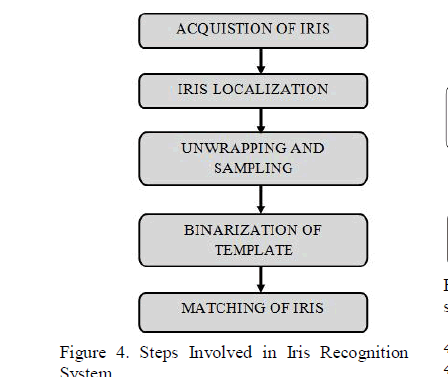 |
3.3FEATURE EXTRACTION FROM FACE
BIOMETRICS |
| Face recognition matching is quite difficult because faces
are multi dimensional and complex. Here, Eigen face
method is used .It converts the full face image into small
set of characteristic feature images. |
| The steps involved in face recognition are: |
| Acquire the face images and calculate the
eigenfaces, which define the face spaces.
When a new face image is encountered,
calculate a set of weights based on the input
image.
Determine if the image is a face at all (whether
it is known or unknown) by checking to see if
the image is sufficiently close to face space. |
IV. TWOTIER SECURITY IN ATM SYSTEM |
| vDue to some unavoidable reasons, the user can’t able to
prove himself as genuine user. At that time, the user
needs to prove himself as a genuine person so the system
generates another combination of biometrics for
authentication to enroll the user as a genuine user with
the onetime password generated by the database. Here
the two level securities take place. |
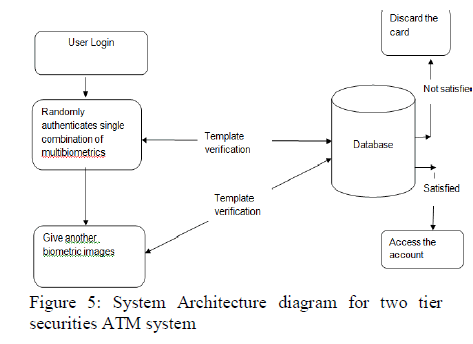 |
4.1 DESCRIPTORS USED
4.1.1 FUZZY COLOR AND TEXTURE HISTOGRAM
(FCTH) |
| It deals the extraction of a new low level feature that
combines, in one histogram, color and texture
information. This feature is named FCTH - Fuzzy Color
and Texture Histogram - and results from the
combination of 3 fuzzy systems. FCTH size is limited to
72 bytes per image, rendering this descriptor suitable for
use in large image databases. It is appropriate for
accurately retrieving images even in distortion cases such
as deformations, noise and smoothing. It is tested on a
large number of images selected from proprietary image
databases or randomly retrieved from popular search
engines. To evaluate the performance of the FCTH
feature, the averaged normalized modified retrieval rank
was used. |
4.1.2 COLOR AND EDGE DIERCTIVITY DESCRIPTOR
(CEDD) |
| The structure of CEDD consists of 6 texture areas. In
particular, each texture area is separated into 24 sub
regions, with each sub region describing a color. CEDD's
color information results from 2 fuzzy systems that map
the colors of the image in a 24-color custom palette. To
extract texture information, CEDD uses a fuzzy version
of the five digital filters proposed by the MPEG-7 EHD.
The CEDD extraction procedure is outlined as follows:
when an image block (rectangular part of the image)
interacts with the system that extracts a CCD, this
section of the image simultaneously goes across 2 units.
The first unit, the color unit, classifies the image block
into one of the 24 shades used by the system. Let the
classification be in the color $m, m \in [0,23]$. The
second unit, the texture unit, classifies this section of the
image in the texture area $a, a \in [0,5]$. The image
block is classified in the bin $a \times 24 + m$. The process is repeated for all the image blocks of the image.
On the completion of the process, the histogram is
normalized within the interval [0,1] and quantized for
binary representation in a three bits per bin quantization. |
V. PERFORMANCE EVALUATION |
| This optimization model is evaluated in terms of its
receiver operating characteristics (ROC) curve for test
data sets. This enables the user to evaluate a model in
terms of the trade-off between sensitivity and specificity.
ROC matrices are used to show how changing detection
threshold affects detection versus false alarms. If the
threshold is set too high then the system will miss too
much detection. Conversely, if the threshold is very low
then there will be heavy false alarms. The percentage of
detections classified correctly is plotted against the
percentage of non –detections in correctly classified as
detections (i.e. false alarms) as a function of the
detection threshold. ROC is the best way to evaluate a
detector [18]. |
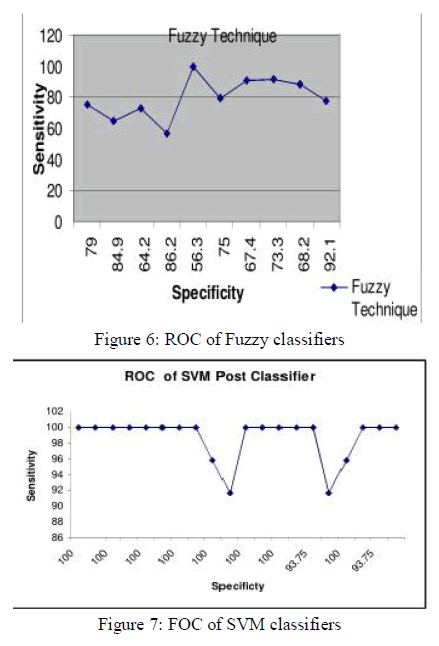 |
VI. CONCLUSION AND FUTURE WORK |
| A feature-level fusion framework for the design of multi
biometric cryptosystems that simultaneously protects the
multiple templates of a user using a single secure sketch.
A realistic security analysis of the multi biometric
cryptosystems has also been conducted. Experiments on
two different multi biometric databases containing
fingerprint, face, and iris modalities demonstrate that it is
indeed possible to improve both the matching
performance and template security using the multi
biometric cryptosystems.
There are four critical issues that need to be investigated
further:1) Embedding schemes for transforming one
biometric representation into another, while preserving
the discriminative power of the original representation;
2) a better feature fusion scheme to generate a compact
multi biometric template that retains most of the
information content in the individual templates;
3)methods to improve the security analysis by accurately
modeling the biometric feature distributions; and 4)
evaluation of the proposed cryptosystem on large
multimodal database. |
References |
- Abhishek Nagar, KarthikNandakumar and Anil K. Jain,âÃâ¬ÃÅMultibiometric Cryptosystems Based on Feature-Level FusionâÃâ¬ÃÂ, IEEEtransactions on information forensics and security ,vol.7,no.1255-268,February, 2012.
- Adams Wai-Kin Kong, âÃâ¬ÃÅModeling Iris Code and ItsVariants as Convex Polyhedral Cones and Its Security ImplicationsâÃâ¬ÃÂ,IEEE transactions on image processing, vol.22, no.3, March,2013.
- Arun Ross and RohinGovindarajan,âÃâ¬Ã Feature Level Fusionin Biometric Systems âÃâ¬ÃÅ, IJCSA, vol 45,no 13,July2012.
- BalajiKrishnapuram, Lawrence Carin, MaÃâô rio A.T.Figueiredo, and Alexander J.Hartemink,âÃâ¬Ã Sparse Multinomial LogisticRegression: Fast Algorithms and Generalization BoundsâÃâ¬ÃÂ.IEEEtransactions on pattern analysis & machine intelligence,vol.27,no.6,June 2005.
- HarbiAlMahafzah, MaâÃâ¬Ãâ¢enZaidAlRwashdeh, âÃâ¬ÃÅA Survey ofMultibiometric SystemsâÃâ¬ÃÂ, IJCSA,vol 43,no 15,July2012.
- Kenneth Revett, PhD, âÃâ¬ÃÅBehavioral biometrics, A RemoteAccess ApproachâÃâ¬ÃÂ, Ãâé 2008 John Wiley & Sons, Ltd. ISBN: 978-0-470-51883-0
- Moses OkechukwuOnyesolu, Moses OkechukwuOnyesolu,âÃâ¬ÃÂATM Security using fingerprint biometric identifier: Aninvestigate study âÃâ¬ÃÅ, IJACSA, Vol.3, 4,2012.
- SabaraDinerstein, Jonathan Dinerstein, and Dan Ventura,âÃâ¬ÃÂRobust Multimodal Biometric Fusion via Multiple SVMsâÃâ¬ÃÂ, IEEEtransactions on pattern analysis & machine intelligence, vol.29,no.8,June 2012.
- ShaikhAnowarul Fattah, Hafiz Imtiaz,âÃâ¬Ã A Spectral DomainDominant Feature Extraction Algorithm for Palmprint RecognitionâÃâ¬ÃÂ,IJIP, vol 5, Issue 2, 2011.
- Umutuludag,Sharathpankanti,Salilprabhakar and Anil k.Jain,âÃâ¬ÃÂBiometric Cryptosystems: Issues and ChallengeâÃâ¬ÃÂs,Proceedings ofthe IEEE,vol.92,no.6,June 2004 .
- Waheeda Al-Mayyan,âÃâ¬ÃÂPerformance Analysis of MultimodalBiometric FusionâÃâ¬ÃÂ,Ph.dThesis,DeMontfort University.2012.
- Yunhong Wang ,Li Ma, Tieniu Tan and Dexin Zhang,âÃâ¬ÃÂPersonal Identification Based on Iris Texture AnalysisâÃâ¬ÃÂ,IEEEtransactions on Pattern analysis & machine intelligenceâÃâ¬ÃÂ, vol.25, Issue12,December 2003.
- S.Pravinthrja and K. Umamaheswari"MultimodalBiometrics for Improving Automatic Teller Machine SecurityâÃâ¬ÃÂ,Bonfring International Journal of Advances in Image Processing,Volume 1, December, 2011.
- ChiragDadlani, Arun Kumar Passi, Herman Sahota andMitinKrishan Kumar, âÃâ¬ÃÅFingerprint Recognition Using Minutiae-BasedFeaturesâÃâ¬ÃÂ,EE85I: Biometrics, Indian Institute of Technology, Delhi.
- Michael Boyd, DragosCarmaciu, Francis Giannaros,Thomas Payne and William Snell,âÃâ¬ÃÅIris RecognitionâÃâ¬ÃÂ, Imperial CollegeLondon, MSc Computing Science Group Project, March 19, 2010.
- RoliBansal, PritiSehgal and PunamBedi âÃâ¬ÃÅEffectiveMorphological Extraction of True Fingerprint Minutiae based on theHit or Miss TransformâÃâ¬ÃÂ, IJBB, Volume 4, Issue 2, 2010.
- B. Yanikoglu and Kholmatov, âÃâ¬ÃÅCombining multiplebiometrics to protect privacyâÃâ¬ÃÂ, in Proc. ICPR-BCTP Workshop,Cambridge, August, England.
- A. KeerthiVasan, R. Harikumar, M. LogeshKumar,âÃâ¬ÃÂPerformance Analysis of Support Vector Machine (SVM) forOptimization of Fuzzy Based Epilepsy Risk Level ClassificationsUsing Different Types of Kernel Functions from EEG SignalParametersâÃâ¬ÃÂ, Proceedings of the International MultiConference ofEngineers and Computer Scientists 2009 Vol I IMECS 2009, March 18- 20, 2009, Hong Kong.
|